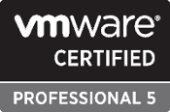The new 1st runner-up spot for VMmark in the “8 core” category was taken yesterday by Dell’s R710 – just edging-out the previous second spot HP ProLiant BL490 G6 by 0.1% – a virtual dead heat. Equipped with a pair of Xeon X5570 ($1386/ea, bulk list) and 96GB registered DDR3/1066 (12x8GB), the 2U, rack mount R710 weighs-in with a tile ratio of 1.43 over 102 VMs. :
- Dell R710 w/redundant high-output power supply, ($18,209)
- 2 x Intel Xeon X5570 Processors (included)
- 96GB ECC DDR3/1066 (12×8GB) (included)
- 2 x Broadcom NexXtreme II 5709 dual-port GigabitEthernet w/TOE (included)
- 1 x Intel PRO 1000VT quad-port GigabitEthernet (1x PCIe-x4 slot, $529)
- 3 x QLogic QLE2462 FC HBA (1x PCIe slot, $1,219/ea)
- 1 x LSI1078 SAS Controller (on-board)
- 8 x 15K SAS OS drive, RAID10 (included)
- Required ProSupport package ($2,164)
- Total as Configured: $24,559 ($241/VM, not including storage)
Three Dell/EMC CX3-40f arrays were used as the storage backing of the test. The storage system included 8GB cache, 2 enclosures and 15, 15K disks per array delivering 19 LUNs at about 300GB each. Intel’s Hyper-Threading and “Turbo Boost” were enabled for 8-thread, 3.33GHz core clocking as was VT; however embedded SATA and USB were disabled as is common practice.
At about $1,445/tile ($241/VM) the new “second dog” delivers its best at a 20% price premium over Lenovo’s “top dog” – although the non-standard OS drive configuration makes-up a half of the difference, with Dell’s mandatory support package making-up the remainder. Using a simple RAID1 SAS and eliminating the support package would have droped the cost to $20,421 – a dead heat with Lenovo at $182/VM.
Comparing the Dell R710 the 2P, 12-core benchmark HP DL385 G6 Istanbul system at 15.54@11 tiles:
- HP DL385 G6 ($5,840)
- 2 x AMD 2435 Istanbul Processors (included)
- 64GB ECC DDR2/667 (8×8GB) ($433/DIMM)
- 2 x Broadcom 5709 dual-port GigabitEthernet (on-board)
- 1 x Intel 82571EB dual-port GigabitEthernet (1x PCIe slot, $150/ea)
- 1 x QLogic QLE2462 FC HBA (1x PCIe slot, $1,219/ea)
- 1 x HP SAS Controller (on-board)
- 2 x SAS OS drive (included)
- $10,673/system total (versus $14,696 complete from HP)
Direct pricing shows Istanbul’s numbers at $1,336/tile ($223/VM) which is a 7.5% savings per-VM over the Dell R710. Going to the street – for memory only – changes the Istanbul picture to $970/tile ($162/VM) representing a 33% savings over the R710.
SOLORI’s Take: Istanbul continues to offer a 20-30% CAPEX value proposition against Nehalem in the virtualization use case – even without IOMMU and higher memory bandwidth promised in upcoming Magny-Cours. With the HE parts running around $500 per processor, the OPEX benefits are there for Istanbul too. It is difficult to understand why HP wants to charge $900/DIMM for 8GB PC-5300 sticks when they are available on the street for 50% less – that’s a 100% markup. Looking at what HP charges for 8GB DDR3/1066 – $1,700/DIM – they are at least consistent. HP’s memory pricing practice makes one thing clear – customers are not buying large memory configurations from their system vendors…
On the contrary, Dell appears to be happy to offer decent prices on 8GB DDR3/1066 with their R710 at approximately $837/DIMM – almost par with street prices. Looking to see if this parity held up with Dell’s AMD offerings, we examined the prices offered with Dell’s R805: while – at $680/DIMM – Dell’s prices were significantly better than HP’s, they still exceeded the market by 50%. Still, we were able to configure a Dell R805 with AMD 2435’s for much less than the equivalent HP system:
- Dell R805 w/redundant power ($7,214)
- 2 x AMD 2435 Istanbul Processors (included)
- 64GB ECC DDR2/667 (8×8GB) ($433/ea, street)
- 4 x Broadcom 5708 GigabitEthernet (on-board)
- 1 x Intel PRO 100oPT dual-port GigabitEthernet (1x PCIe slot, included)
- 1 x QLogic QLE2462 FC HBA (1x PCIe slot, included)
- 1 x Dell PERC SAS Controller (on-board)
- 2 x SAS OS drive (included)
- $10,678/system total (versus $12,702 complete from Dell)
This offering from Dell should be able to deliver equivalent performance with HP’s DL385 G6 and likewise savings/VM compared to the Nehalem-based R710. Even at the $12,702 price as delivered from Dell, the R805 represents a potential $192/VM price point – about $50/VM (25%) savings over the R710.







